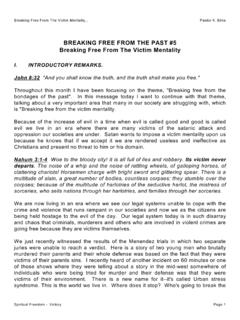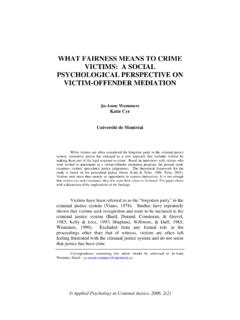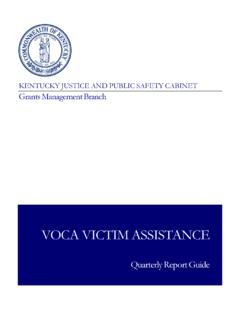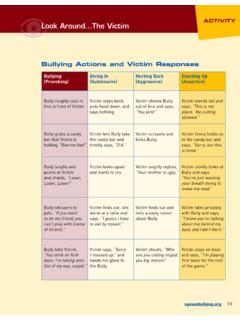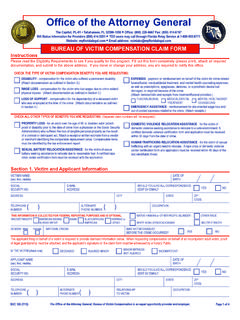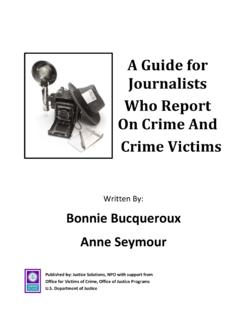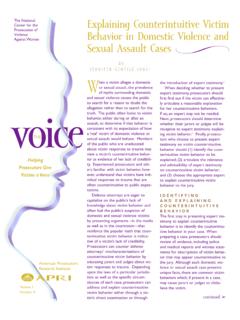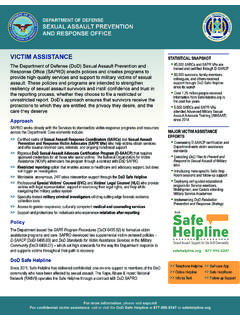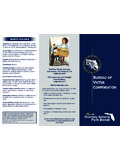Transcription of Conflict Drama: Victim, Villain or Hero?
1 Copyright 2003 Gary Harper Conflict drama : Victim, Villain or Hero? page 1 of 4 Conflict drama : Victim, Villain or Hero? What s Your Story? In Conflict , everyone has a story and there are at least two sides to every story. We can better understand these stories by prefacing them with the words Once upon a time. Fairy tale archetypes allow us to see the Conflict and our roles differently and to find more constructive ways approach the situation. Fairy tales feature three main types of characters: the victim (often represented as a damsel in distress or an innocent youth); the Villain (a witch, giant or dragon); and the hero (the white knight or prince). We encounter these same character types on the front page of our newspapers, in our favourite television shows and on movie screens everywhere.
2 Not surprisingly, we relate to these larger-than-life characters and even subconsciously view the world in their terms. Most often we see ourselves as the victim innocent and powerless. Sometimes we play the hero and risk the discomfort of Conflict to right the wrong and see justice done. And very occasionally we may even slip into the role of the Villain , venting our anger or frustration on another person. Each role provides a limited perspective on the Conflict . Together they form a drama triangle. People in Conflict often talk of feeling stuck trapped not by the Conflict , but on a drama triangle of victims , villains and heroes. Once we are aware of it, we can step back and acknowledge our place on the drama triangle and choose to view and approach our conflicts differently.
3 We can see our adversary not as the Villain , but as someone with whom we must work to identify and solve the problem. In doing so, we move beyond the drama triangle and towards resolution. Roles We Play In Conflict , we have a unique perspective on the part we play. We may also move from role to role as the Conflict unfolds. Innocent victim Because Conflict involves an attack or threat to us or our needs, we feel victimized. With the victim role comes a belief in our innocence as well as a feeling of powerlessness. We might withdraw the flight part of fight or flight or even freeze like a deer caught in the headlights. Other times we wait for something to change or for someone to rescue us. (Remember Rapunzel, trapped in her tower.) Although some people suffer in silence, we often express our frustration by complaining about the situation and blaming the person we see as responsible for our plight (the Villain ).
4 Copyright 2003 Gary Harper Conflict drama : Victim, Villain or Hero? page 2 of 4 Noble hero Though we initially experience Conflict from victim mode, we may shift to hero mode to protect ourselves, defend our interests and even the score. This role encompasses courage and action, selflessness and nobility. The hero ventures forth to do what must be done justice will be its own reward. The role represents the part of us that will step forward and risk taking a stand, despite our discomfort or fear. There is a darker side to the hero role, however, when righteousness becomes self-righteousness. In the pursuit of justice, the hero slays or captures the Villain . When we agree that the hero s cause is just, we condone and even applaud these aggressive behaviours.
5 We justify our own aggressive, hurtful behaviour by telling ourselves They had it coming. Based on actions alone, a hero is simply a self-righteous Villain . In a different context, Robin Hood would have done five to ten years of hard time for extortion and armed robbery. Instead, his actions are not only excused, but revered in legend because of his noble cause and earlier mistreatment by the evil Sheriff. Similarly, Jack (of Jack and the Beanstalk fame) made his reputation through trespass and burglary, though these acts are seen as heroic because the giant was mean. Evil Villain Villains manipulate, control or deprive the victim for their own ends. This role represents the side of us that can be mean-spirited and vindictive (what Star Wars calls the dark side of the Force).
6 This dark side is selfish, controlling and fearful. The Villain attacks and takes what they want without concern for the impact on others. These tactics are used to control; when we experience someone controlling us, we quickly cast them as the Villain in our Conflict story. In fact, the behaviours of the Villain are similar to those of the hero, distinguished only by how we judge them. Internationally, acts of violence we condemn as terrorism are seen as the selfless deeds of freedom fighters by other ideologies. Looking strictly at behaviour in Conflict , a Villain is simply a misunderstood hero. Even people who act inappropriately or antisocially have their story, in which they see themselves as victims and in which they justify their actions as evening the score.
7 One person s justice is another s revenge. Stuck on the drama Triangle When we see ourselves as victims or heroes, we automatically create villains in our conflicts . When we see (and treat) someone like a Villain , they in turn feel victimized by us and see us as the Villain . Behaviours they consider self-defence, we experience as attacks and further evidence that we cannot trust or work with them. And the walls of judgement and justification thicken on both sides. Copyright 2003 Gary Harper Conflict drama : Victim, Villain or Hero? page 3 of 4 The drama triangle and its roles inevitably produce a win-lose approach to Conflict . One person wins; the other must lose. No one likes to lose, and we will battle ferociously to avoid defeat. Even if one person loses the battle, the war is seldom over.
8 The loser continues to seek justice and retribution. The cycle of revenge that underlies Conflict persists and ultimately leads to a lose-lose situation. Casting New Roles How do we escape the drama triangle? We can shift our perspective to seek resolution instead of victory. We can explore possibilities that allow both sides to get what they need. Let s start with the role of victim. From passive victim to assertion To set aside the role of victim is easier said than done. We begin by taking responsibility for our feelings and reactions in Conflict . We do not have to deny or devalue our feelings or needs, but can accept them as our own. After all, whose problem is it if you go home frustrated with your boss at the end of a workday? Who owns the problem?
9 (Hint: Your boss may be sleeping like a baby as you lie awake endlessly replaying the events of the day.) Consider the difference between the statements You never make time for my issues at meetings (victim) and I m frustrated that we didn t discuss the budget during the meeting (accountable). The first statement is loaded with judgement, casts the other person as the Villain , and blames them for how we feel. The latter shares information, takes responsibility for feelings and begins to identify the problem to be discussed and resolved. Similarly, we can ask directly for what we need instead of quietly complaining to others about our plight. This is uncomfortable, yet empowering. It s uncomfortable because we can no longer blame others and refuse to change, empowering because we become an active participant in shaping our life.
10 To reap the rewards of assertiveness, we must risk the discomfort of confronting a person or problem. From hero to problem-solver The role of hero can be as unproductive as that of victim in resolving Conflict . This self-righteous mindset condones our attack on the Villain as justice. Attack is met with counterattack; the Conflict persists and usually escalates. Our ego fuels the need to be right and we become attached to a specific outcome. At this point, the Conflict often becomes a power struggle. We can address and resolve Conflict much more productively if we let go of the need to be right and focus instead on ways to get our needs met. This opens up possibilities we might otherwise ignore. The energy devoted to a win-lose power struggle can instead be applied to problem solving.

